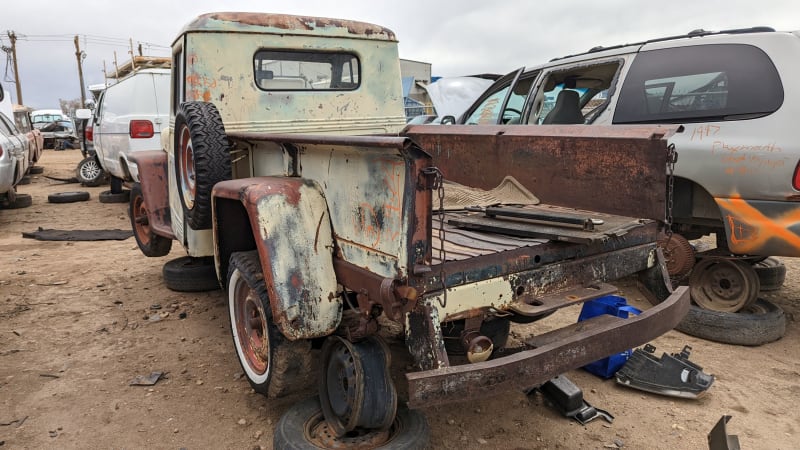After building hundreds of thousands of examples of the original Jeep during World War II, Willys-Overland Motors needed to hustle to design and build machines that civilians (other than farmers) would want to buy. Rather than resume production of prewar Willys cars, the company hired soon-to-be-legendary designer Brooks Stevens to take its military vehicle designs and make something a bit more civilized. The result was the Willys-Overland Jeep Station Wagon, which looked stylish despite its flat stamped body panels, making its debut for the 1946 model year. A year later, a pickup version known as the “Jeep” Truck (don’t laugh; Toyota called the Hilux the Toyota Truck here for many years, and the Jeep designation was in quotes because Willys-Overland didn’t get exclusive rights to the Jeep trademark until 1950) appeared. Today’s Junkyard Gem is one of those early Trucks, found in a self-service yard between Denver and Cheyenne.
The ancient, rotted tires tell us that this Truck spent many decades sitting outdoors in the harsh climate of Colorado (or maybe Wyoming or western Kansas), gradually sinking into the soil alongside the cacti, tumbleweed, and sage of the High Plains.
It could be any model year from 1947 through 1949. All the identifying numbers or build plates that might have told me the exact year were long gone by the time I got here.
The engine in the 1947-1949 Willys-Overland “Jeep” Truck was a 134-cubic-inch (2.0-liter) “Go-Devil” flathead, rated at 63 horsepower. Torque was decent, at 106 lb-ft. Keep in mind that the curb weight of this truck was a mere 3,129 pounds (about the same as a new Corolla today) when contemplating those power numbers.
This is essentially the same engine that powered all those WW2 Jeeps that helped crush the Axis.
The only transmission available was a three-on-the-floor synchromesh manual. The two short levers to the right of the gearshift are for choosing 2WD/4WD and high/low final drive ratio.
I came close to purchasing this beautiful gauge cluster for display on my garage wall, but I’m running out of room for such stuff.
This depth of rodent nesting material is scary when you live in Hantavirus country, so I tried to hold my breath when shooting photos in the cab.
The four-wheel-drive version of the Willys Overland “Jeep” Truck cost $1,792 in 1949, which comes to about $21,585 in 2022 dollars.
There isn’t much to go wrong with these trucks, but this one proved too rough to be worth fixing up. Let’s hope its parts live on in other Willys vehicles before the crusher eats it.
So useful! Willys-Overland got back into the car business in 1952, with the Aero Willys, then was purchased by Kaiser the following year. Aero production continued in Brazil into the early 1970s.
Related Video:










